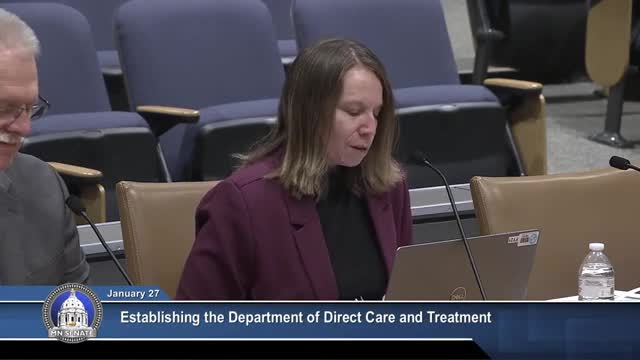Minnesota's Direct Care and Treatment faces staffing crisis amid rising patient demand
January 27, 2025 | 2025 Legislature MN, Minnesota
This article was created by AI summarizing key points discussed. AI makes mistakes, so for full details and context, please refer to the video of the full meeting. Please report any errors so we can fix them. Report an error »

In a recent meeting of the Minnesota Senate's Committee on Human Services, officials from the Direct Care and Treatment (DCT) system outlined the critical challenges facing the state's unique behavioral health care system. DCT, which serves approximately 12,000 patients annually, is the only facility of its kind in Minnesota, specializing in treating individuals with complex mental health and behavioral issues that other providers often cannot accommodate.
The meeting highlighted the pressing issue of staffing shortages, a concern echoed across the healthcare sector. DCT has recently hired 100 new staff members but still faces a significant gap, with many direct care positions remaining unfilled. This shortage has led to increased overtime for existing staff, contributing to burnout and raising concerns about the quality of care provided to patients. DCT officials emphasized that without adequate staffing, the safety of both patients and staff could be compromised.
Another significant topic discussed was the rising demand for services. DCT is experiencing an influx of patients with high levels of aggression and volatility, which has strained its limited treatment capacity. The waiting list for admission continues to grow, prompting DCT to explore ways to expand its facilities. Recent efforts include increasing the capacity of the child and adolescent behavioral health hospital in Wilmer and reopening the Ironwood unit at the forensic mental health program in Saint Peter.
Discharge difficulties were also a focal point of the discussion. Many patients remain in DCT facilities longer than necessary due to a lack of community-based treatment options. This bottleneck prevents new patients from being admitted, further exacerbating the waiting list issue. DCT officials noted that collaborative efforts with counties have improved the situation, reducing the percentage of patients waiting at the Anoka Metro Regional Treatment Center from 40% to 28%.
The meeting concluded with a mention of a forthcoming report from the priority admissions review panel, due on February 15. This report will provide recommendations on how to prioritize admissions, particularly for individuals coming from jails, based on various factors including medical acuity and treatment accessibility.
As Minnesota continues to navigate the complexities of its behavioral health care system, the discussions at this meeting underscore the urgent need for solutions to staffing shortages, treatment capacity, and discharge processes to ensure that all patients receive the care they need.
The meeting highlighted the pressing issue of staffing shortages, a concern echoed across the healthcare sector. DCT has recently hired 100 new staff members but still faces a significant gap, with many direct care positions remaining unfilled. This shortage has led to increased overtime for existing staff, contributing to burnout and raising concerns about the quality of care provided to patients. DCT officials emphasized that without adequate staffing, the safety of both patients and staff could be compromised.
Another significant topic discussed was the rising demand for services. DCT is experiencing an influx of patients with high levels of aggression and volatility, which has strained its limited treatment capacity. The waiting list for admission continues to grow, prompting DCT to explore ways to expand its facilities. Recent efforts include increasing the capacity of the child and adolescent behavioral health hospital in Wilmer and reopening the Ironwood unit at the forensic mental health program in Saint Peter.
Discharge difficulties were also a focal point of the discussion. Many patients remain in DCT facilities longer than necessary due to a lack of community-based treatment options. This bottleneck prevents new patients from being admitted, further exacerbating the waiting list issue. DCT officials noted that collaborative efforts with counties have improved the situation, reducing the percentage of patients waiting at the Anoka Metro Regional Treatment Center from 40% to 28%.
The meeting concluded with a mention of a forthcoming report from the priority admissions review panel, due on February 15. This report will provide recommendations on how to prioritize admissions, particularly for individuals coming from jails, based on various factors including medical acuity and treatment accessibility.
As Minnesota continues to navigate the complexities of its behavioral health care system, the discussions at this meeting underscore the urgent need for solutions to staffing shortages, treatment capacity, and discharge processes to ensure that all patients receive the care they need.
View full meeting
This article is based on a recent meeting—watch the full video and explore the complete transcript for deeper insights into the discussion.
View full meeting
